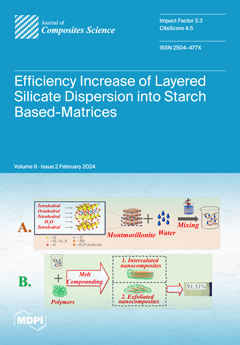In this work, novel multifunctional electrospun nanofibrous membranes made of polyamide (PA6) and loaded with silica (SiO
2) and/or titanium dioxide (TiO
2) nanoparticles were fabricated. SiO
2 NPs were first prepared and then characterized by TEM, FE-SEM, and FTIR, and
[...] Read more.
In this work, novel multifunctional electrospun nanofibrous membranes made of polyamide (PA6) and loaded with silica (SiO
2) and/or titanium dioxide (TiO
2) nanoparticles were fabricated. SiO
2 NPs were first prepared and then characterized by TEM, FE-SEM, and FTIR, and by using XRD techniques, confirming the formation of cristobalite tetragonal crystals with high purity. Different nanofibrous mats, loaded with SiO
2 NPs, TiO
2 NPs, or both SiO
2 and TiO
2 NPs, were investigated. Morphological studies indicated that SiO
2 and TiO
2 nanoparticles tend to be arranged along the fiber surface, also promoting the formation of anatase nanorods when they are mixed into the nanofibers. In this last scenario, mechanical tests have demonstrated that the presence of SiO
2 contributed to balancing the mechanical response of fibers that are negatively affected by the presence of TiO
2 NPs—as confirmed by tensile tests. More interestingly, the presence of SiO
2 did not negatively affect the antibacterial response against different bacteria populations (i.e.,
Escherichia coli, Klebsiella pneumonia, Staphylococcus aureus, Bacillus subtilis, and
Candida albicans), which is mainly ascribable to the presence of TiO
2 particles. Accordingly, the TiO
2- and TiO
2/SiO
2-loaded fibers showed higher methylene blue (MB) absorption values—i.e., 26 mg/g and 27 mg/g—respectively, compared to the SiO
2-loaded fibers (23 mg/g), with kinetics in good agreement with the second-order kinetic model. The obtained findings pave the way for the formation of novel antibacterial membranes with a promising use in water purification.
Full article





